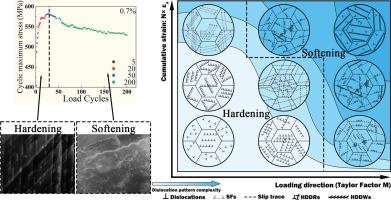In-Situ Electron Channeling Contrast Imaging of Cyclic Deformation Mechanisms in CrCoNi Medium-Entropy Alloy
IF 9.3
1区 材料科学
Q1 MATERIALS SCIENCE, MULTIDISCIPLINARY
引用次数: 0
Abstract
This study investigates the microstructural evolution and cyclic stress response of a CrCoNi medium-entropy alloy as a function of strain amplitude (0.7% and 0.9%), cycle number (N, up to 200 cycles), and Taylor factor (M = 2.3–3.6) using in-situ electron channeling contrast imaging (ECCI). In an initial stage (N < 20 cycles), dislocations multiply uniformly across all grains for both strain amplitudes. Subsequently (N > 50 cycles), grains with low Taylor factors (M = 2.3–2.8) retain planar slip arrays, those with medium Taylor factors (M= 2.8–3.2) develop transitional dislocation structures, while grains with high Taylor factors (M = 3.2–3.6) form fully heterogeneous structures through multi-slip activation. This microstructural evolution directly correlates with the mechanical response: low-M grains exhibit continuous hardening as a result of planar slip, medium-M grains display slightly lower hardening, while high-M grains undergo cyclic softening. The softening in high-M grains stems from the formation of low-density dislocation channels, increasing the dislocation mean free path and reducing back stress. A constitutive model incorporating the Taylor factor distribution and these evolving dislocation configurations quantitatively predicts the cyclic stress response, confirming that softening originates from heterogeneous structures in grains with high Taylor factor. This work thus identifies the Taylor factor-dependent formation of heterogeneous structures, observed via ECCI, as the critical mechanism driving cyclic softening. These findings offer a crystallographic perspective for designing fatigue-resistant multi-principal element alloys.

CrCoNi中熵合金循环变形机制的原位电子通道对比成像
采用原位电子通道对比成像技术(ECCI)研究了CrCoNi中熵合金的微观组织演变和循环应力响应与应变幅值(0.7%和0.9%)、循环数(N,最多200次循环)和Taylor因子(M = 2.3-3.6)的关系。在初始阶段(N <; 20个循环),对于两种应变振幅,位错均匀地在所有晶粒中倍增。随后(N >; 50个循环),低泰勒因子(M = 2.3-2.8)的晶粒保留平面滑移阵列,中等泰勒因子(M= 2.8-3.2)的晶粒发育过渡性位错结构,高泰勒因子(M = 3.2-3.6)的晶粒通过多滑移激活形成完全非均质结构。这种微观组织演变与力学响应直接相关:低m晶粒由于平面滑移而表现为连续硬化,中等m晶粒表现为轻度硬化,而高m晶粒则表现为循环软化。高m晶粒的软化源于低密度位错通道的形成,位错平均自由径增大,背应力减小。结合泰勒因子分布和这些演变的位错构型的本构模型定量预测了循环应力响应,证实了软化源于高泰勒因子的晶粒中的非均质结构。因此,这项工作确定了通过ECCI观察到的依赖泰勒因子的非均质结构的形成,作为驱动循环软化的关键机制。这些发现为设计抗疲劳多主元素合金提供了一个晶体学的视角。
本文章由计算机程序翻译,如有差异,请以英文原文为准。
求助全文
约1分钟内获得全文
求助全文
来源期刊

Acta Materialia
工程技术-材料科学:综合
CiteScore
16.10
自引率
8.50%
发文量
801
审稿时长
53 days
期刊介绍:
Acta Materialia serves as a platform for publishing full-length, original papers and commissioned overviews that contribute to a profound understanding of the correlation between the processing, structure, and properties of inorganic materials. The journal seeks papers with high impact potential or those that significantly propel the field forward. The scope includes the atomic and molecular arrangements, chemical and electronic structures, and microstructure of materials, focusing on their mechanical or functional behavior across all length scales, including nanostructures.
 求助内容:
求助内容: 应助结果提醒方式:
应助结果提醒方式:


